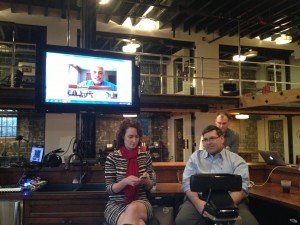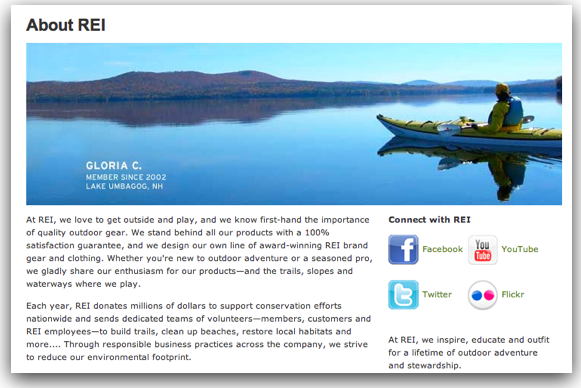
Want to learn more about Content Marketing? Join our Google+ Content Marketing Community!
A live blog of the presentations of three incredible content marketing ninjas at the Raleigh SEO Meetup, 26 March 2013.
Casie Gillette @casieg KoMarketing Associates
Amy Lewis @commsninja Cisco
Marty Smith @scenttrail AtlanticBT
Casie Gillette: Content is for Search, Branding & Authorship
Needed to find ways to help clients take advantage of universal search as it came in. They created tons of content and saw organic traffic increase correspondingly.
You have to create content that people like and want to share. Think about what your customers want to read. Don’t just talk about your product or service.
Freshbooks has over 80K links to their blog. Their market is small businesses and entrepreneurs. So they write about entrepreneurship and the concerns those people have.
Herman Miller knows there’s only so much you can say about an office chair. So they write about things like office exercise and ergonomics and office design: content their market will be into. They ran a contest for students to design a chair, and they actually made the winning chair.
Grasshopper is a “boring” product (phone systems), but they made videos about entrepreneurship because that’s their market.
Simply Business is an insurance broker for businesses. They created cool interactive infographics that were helpful to small businesses. Also created guides for small businesses for using web tools.
Her main advice is to plan. Get EditFlow for WordPress, a plugin that enables collaboration and a team editorial calendar. She plans three months out.
How do you find people to produce your content? Casie held a contest in her company with a prize for whoever’s content had the most page views at the end of each month. Ask partners and customers to write guest posts.
Go forth and multiply your content efforts! Don’t use content just once. Repurpose it in different ways (eBook, Slideshare, video, etc.).
What about content marketing as a link building effort? It takes several months to build up enough momentum and shares to start getting those links and shares. Write news stories to get picked up in Google News. Most of your links should occur naturally as people are exposed to the content and want to reshare it.
What do you do with existing content that doesn’t seem to be working? Casie never dumps content unless it’s really become irrelevant. Rather, repurpose it in new ways that will be more relevant to established targets.
Martin Smith: Storytelling Is the New SEO
Slide deck for this presentation:
Content can’t go viral without “big guns.” Marty has gone viral 5 times out of over 1000 content pieces, and in every case a big gun picked it up and shared it.
Google’s algorithm changes. Google had painted itself into a corner where it was too easy to game search. Panda and Penguin came along because Google wanted to value:
- content
- engagement
- storytelling
And it gave them a chance to show there is a new sheriff in town
Curation is finding content that fits for your audience and resharing it across your social ecosystem. It’s all about the shares; create content that will get shared. Marty got tonight’s slide deck to be featured on Slideshare by sharing it to his powerful ScoopIt network.
Marty does more curation than creation, because more content brings more attention, not only by people but by the search engines. He adds his own take to everything he reshares.
Content Marketing Matrix
How do you know what content will work for you?
- The more NOW your content is, the more valuable it is.
- Will it convert? A conversion could be as little as getting someone to stay on your site for 3 minutes or more. Time on site is essential to good Google ranking.
Marty tests content on sites like ScoopIt first. If it goes viral there, he builds it out into a bigger blog post. (Google Analytics under counts social by 30%)
High Engagement/High Conversion Content:
- – videos
- – reviews
- – social shares
- – tribal(bought x, who bought y)
- – real time offers
- – breaking news
- – stories
According to Joseph Campbell all stories are essentially the same. Reluctant hero goes on a magical journey, gets mentored, wins a victory, comes back home much wiser. How do you tell this on an ecommerce site? The secret to your storytelling is your About page! If done correctly it provides a guide to your brand’s story. Examples: REI, Patagoinia. REI’s product pages repeat the key themes of their About story.

Faith Popcorn: “people don’t buy brands; they join them.” Invite people to join your brand’s hero’s journey. Cultivate relationships with the people who help your journey. Love them, love your content, love your story.
Should your About story be written first or third person? Marty doesn’t think it matters. Just keep consistent with the voice of the rest of your site. Websites communicate in overt (“We’re easy to deal with”) and covert (site is hard to navigate) ways. You know you’ve got something when people actually share your About page!
If you’re creating a video for your about page, keep it consistent with the story of page. Use it to tell your brand’s creation story. Tell amazing, save the world stories. Air conditioning service isn’t boring if you live in North Carolina! See Jim Stengle’s book Grow: Align your brand with the thing’s consumers want, things like pride, joy, and exploration.
If you want interaction, you need to incentivize it. Gamification is one way to do it. Get some comments started to “seed” more. Create rewards to incentivize extrinsic actions rather than intrinsic (Daniel Pink “Drive”). 70% of the people in your tribe want to help you, but you have to want their help and ask for it.
Consistency: Marty gets the audience he has largely by writing every. single. day. Come hell or high water. Also, be authentic. Don’t compromise the integrity of the network you’ve built.
Amy Lewis: The New Content Marketing Is Not for Wimps: 3 Steps to Staying Ahead

Tip: People love to co-create, and they love to be mentioned. Involve influencers in your content projects.
1. Improvisation
Create content in the moment. Example:stick an expert in front of a whiteboard and just let him talk about his passion.
Think in different forms. Video. Podcast. If you have regular conversations over beer, why not record them? Take lots of pictures and review them for content inspiration.
2. Curation
Use social media as a buffer to “vet” the possible content. Check your own outbound stream and ask if you’d follow this person. Curate like you would if you had to listen to yourself
3. Amplification
Get rock stars on your side. Engage broadly, not just in your bubble. Create content with your amplification ideas in mind. Build an influencer into your content to grab their attention and desire to share.
Be willing to try multiple platforms. Find where your audience is living.
What if you don’t have a “forward” personality to represent your brand, or C level is reluctant? Someone needs to model and show the results. Someone needs to jump in the pool and be willing to look foolish. Have someone who likes to write white papers? Show them that blogs are just quick white papers.
Here is the video recording of the Google+ Hangout On Air live broadcast of this event, courtesy of Raleigh SEO Meetup and Talking Moose Media:









